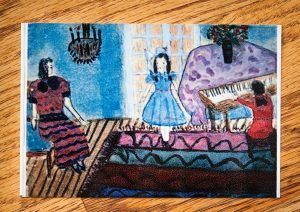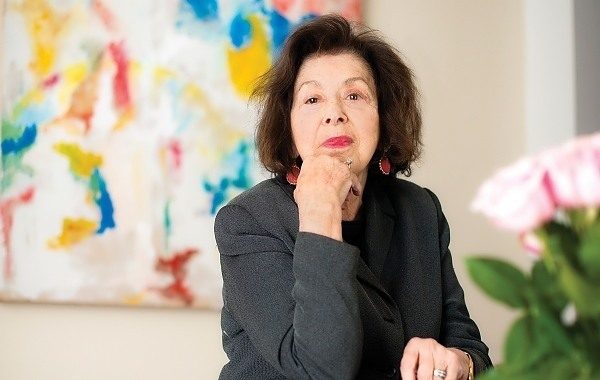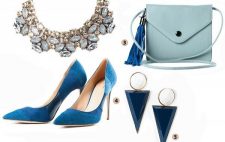
Nelly Toll’s childhood painting of Cinderella is on special exhibit in Germany
It is clearly a watercolor painted by a child. Cinderella is wearing a baby-blue dress, her hair in braids with matching bows. A princess greets her in a drawing room where another woman sits playing the piano. Ironically, the brightly colored scene couldn’t be further from the life of the young artist – then 6-year-old Nelly Toll. Toll created her art during the nearly two years she spent hiding in a locked room with her mother, waiting for Poland to be liberated from the Nazis.
As Toll recalls that time so long ago, she smiles at her rendition of Cinderella being greeted by a beautiful princess and not a handsome prince. But Toll, who now lives in Voorhees with her husband Erv, has always thought outside the box. Even while living within one.
Her odyssey began in 1943 when Germany was invading Poland, rounding up Jews and other people they considered undesirable.
“The Jews were being taken by the Germans to be killed,” Toll says. Her father found refuge for his wife and daughter in the home of a tenant who was renting an apartment from him.
“We lived in an apartment on the street level in a very fashionable Christian neighborhood,” Toll recalls. “My father was going to join us later on, after he placed other family members. To keep me busy, my mother got me a watercolor box. I just made fairytales of a happy childhood.
My mother taught me how to write. The people who hid us couldn’t read or write, but they had a friend who could go to the library. She could only bring grown-up books, because she had no children. So I read Maupassant, Dostoyevsky, Tolstoy, Gorky, and my mother made it easier for me to understand.”
The room had three sections: one for Toll and her mother; one for the tenant, a man she calls Mr. W; and the third housed a beat-up sofa where the man’s wife slept. There was also a bathroom and kitchen.
“We had what I call a double-decker danger on the outside and the inside,” she says. “Outside, the Germans could come at any moment. Inside, the man used to beat his wife terribly. She would sometimes get on the windowsill in the kitchen and call for the police, and we were in that room while the police came to the kitchen.”
“The doors were locked so Mrs. W would pretend to look for a key, at which point we would disappear to a hidden place in that room. I knew that if she turned the key to show them the room, it had to be empty and free of the watercolors, water and brushes. I couldn’t spill a drop of water. There could be no evidence that we were there. It was a matter of a few seconds that this had to be done. We would go into a hidden window.”
“Before the war the room had three windows, and it was very cold. So my father bricked a window on the outside, but inside there was a windowsill. So he put in a wooden board and trap door, and when we needed to we would go in there and put a rug over it. It was touch and go because there was so little time. The police would ask Mrs. W why it took so long to look for a key.”
During air raids, Toll and her mother couldn’t be seen going to an air raid shelter for fear of being turned in, so they would hide in the bathtub. One of her pictures shows two women vacationing in the country in a red house.
“Afterward, they would be tired and the chambermaid would make a beautiful bath,” Toll says, describing how she reinterpreted the bathtub in her painting.
Though Toll doesn’t remember how she learned the story of Cinderella, she created a series of pictures to illustrate her version of the tale. “This Cinderella had a bad stepmother, so she ran away,” Toll says.
“A butler lets her in, and she goes into this room where the princess sits on one chair and on the other end is a woman playing the piano. Cinderella is received by the princess and in the next picture they go into a car – that was a big deal in those days – and they go for a ride.”
Alongside the pictures, Toll included written narrations of her illustrations. She created 60 stories during her time in hiding, most recalling what her life had been like before the war. She and her younger brother were raised in an affluent family, living in an apartment house in Lwow [now Lviv], Poland, where her mother loved to play the piano.
While most of Toll’s pictures depict happy scenes, she drew one black-and-white picture of marching German soldiers. She was also more realistic about her life in the diary she kept.
“I recorded everything. That became the basis for my book, ‘Behind the Secret Window,’” she says. “That diary is still in my possession.”
Toll vividly recalls the day the Russians liberated Poland. “When the Russians came I disregarded my mother and ran out of the house. The soldiers put me on top of their tank and gave me chocolates,” she remembers. Sadly, she never saw her father, younger brother or cousins again.
Toll migrated to the United States in 1951, first landing in Vineland. She got married and settled in Cherry Hill. Today Toll’s home is filled with her artwork, mostly watercolors, along with some pottery. Some pieces are from long ago, while others are very recent. “I love color,” she says. “There’s no inspiration, I just paint.”
Toll recently returned from Berlin, Germany, where alongside German Chancellor Angela Merkel, she opened the exhibit “Art from the Holocaust” at the Yad Vashem – World Center for Holocaust Research. The exhibit featured two of her watercolors.
“At first I didn’t want to go,” she admits. Though she has traveled extensively, she has never had an interest in going to Germany. But at the urging of Yad Vashem officials, and with the chance to meet Chancellor Merkel, she decided to attend. Toll was the only exhibitor still alive.
“The people I was with in Berlin were in their 50s, second and third generation,” she says. “I didn’t feel anger toward them. At the exhibit opening I sat up front. It was Chancellor Merkel, me and my husband and the head of Berlin’s Culture and Arts. I felt most comfortable with Merkel – quite a leader, very strong – and she believes in equality for all people.”
While most of the exhibit’s 100 works by 50 Holocaust-era artists were dark and depressing, Toll’s imagined a brighter world outside. “Mine were the only happy pictures,” she says.
Many of Toll’s paintings, including seven contemporary works, are now part of a traveling show of facsimiles, first exhibited at the Massillon Museum in Ohio. During the show’s recent run in San Antonio, Texas, Toll spoke with students, one of her favorite pastimes.
“We must have had 200 kids, mostly Hispanic, from a Catholic school, which was fabulous,” she recalls. “They sat on the floor and didn’t make a sound. I told them that at that time, the Germans wanted only children who were blond, blue-eyed and of the Aryan race. One boy, about 10 years old, raised his hand and said, ‘So if I dyed my hair blond, would I stay alive?’ That was such a good, thought-out question, but a perplexing one. I said, ‘Even if you dyed your hair, if your parents were Jewish, it didn’t matter.’”
Toll teaches a college course about the Holocaust at the University of Pennsylvania and speaks to school groups about her experience.
“The most important lesson is not to be prejudiced and not to attack those who are unlike them,” she says. “And not to be a quiet bystander.”












